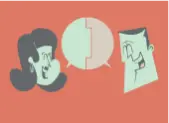- sales
- Blog post
When you must challenge a buyer’s deeply held beliefs
One of the toughest challenges any salesperson faces is a buyer who’s convinced of something that’s flat out wrong.
For example:
- “Seems like every month, your bill is bigger than the one before.”
- “Our current vendor has the most reliable products on the market today.”
- “We’ve heard that recommendation before, and it never works.”
So what’s the best way to move a prospect or customer away from a deeply-held, but erroneous belief?
A fascinating study suggests that you use images rather than words. The research comes from the world of politics, but the results are relevant to sales – especially sales involving high emotions and core values.
In the experiment, the researchers presented people with information facts that contradicted their political beliefs. They deliberately chose highly polarizing issues that make people really dig in their heels.
People who’d opposed President Bush’s “surge strategy” in the Iraq war were presented with evidence that the strategy had in fact reduced violence in Iraq. And people who disapproved of Barack Obama’s handling of the economy were shown evidence showing that jobs had increased during the first year of his presidency.
The point of this experiment wasn’t to prove anyone wrong or promote a specific political agenda. The researchers simply wanted to know how to get people to consider factual evidence that contradicted their deeply held views.
They tested three approaches
- Present a paragraph explaining the new data
- Summarize the evidence in a chart, and
- Build up the buyer’s self esteem before presenting the new evidence
The most effective of the three techniques? Presenting the information in a chart. (Nyhan & Reifler: Opening the political mind. Dartmouth University, 2011.)
Cognitive researchers propose an intriguing reason for the power of visuals to unseat such deeply entrenched beliefs.
They suggest that the human brain has evolved in such a way that it’s more likely to see visuals as “true” and words as, literally, “debatable.”
It seems that when evidence is presented in words, our brains tend to view them as part of an “argument.” So when that evidence contradicts our beliefs, the brain begins creating counterarguments. Present that same evidence visually, however, and we process it differently. We see it as “real” in a way that mere words are not.
It’s no secret, of course, that visuals are extremely powerful tools of persuasion. A classic study from the University of Minnesota, for example, found that presentations using visual aids are 43% more persuasive than unaided presentations. (Vogel, Dickson & Lehman. Persuasion and the role of visual presentation support. University of Minnesota, 1986.)
The Minnesota study also found that visuals don’t have to be especially striking, provocative or even attractive to persuade. Images don’t work because they’re pretty. They work because that’s how the brain prefers to get its information.
Images are the “native language” of the brain. More of the brain’s processing power is devoted to visual information. We understand images more quickly than words and remember them longer. When what we see conflicts with what we hear, our brains choose vision over sound. And neurological studies show that the brain has to work much harder to process words than pictures, creating more opportunities for the information to be corrupted, manipulated, modified or misunderstood.
The bottom line: When you need to change someone’s mind, use images.

Get a demo of all our training features
Connect with an expert for a one-on-one demonstration of how Rapid Learning can help develop your team.


